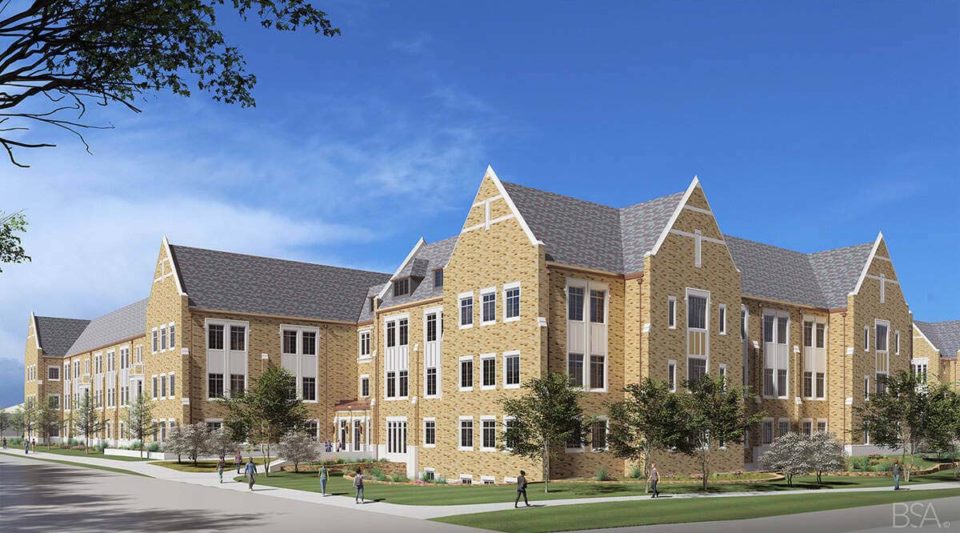The University of Notre Dame will expand its interdisciplinary science and engineering research complex on the east side of campus with the addition of a second building underwritten by a lead gift from alumnus and Emeritus Trustee Ted H. McCourtney and his wife, Tracy.
The second building in the East Campus Research Complex will connect to the original three-story McCourtney Hall and facilitate the growth of interdisciplinary research at the University, with a core focus of the future of health at the crossroads of science and engineering. The McCourtneys supported the first research building in the complex, the McCourtney Hall of Molecular Science and Engineering, with a leadership gift in 2014.
“Thanks to Ted and Tracy’s extraordinary generosity, Notre Dame is able to provide its researchers and scholars with world-class interdisciplinary research facilities – facilities that will make possible remarkable global advancements while also having great impact in this region we are proud to call home,” said University President Rev. John I. Jenkins, C.S.C. “Notre Dame is richly blessed by their vision and support, and on behalf of the entire University community, I offer my heartfelt gratitude for their cherished friendship and inspiring leadership. In their unwavering commitment to be a force for good, Ted and Tracy embody the very best of Notre Dame.”
Since its opening in 2016, McCourtney Hall has had a transformational impact on Notre Dame’s research capabilities. This second building is expected to build on the successful work already underway and become a nexus among science, engineering and social impact.
“The original McCourtney Hall had a profound impact on our faculty and students’ ability to do cutting edge research on molecular science and engineering. It also helped us to recruit the outstanding mission-oriented scholars to Notre Dame,” said Robert J. Bernhard, vice president for research and professor of aerospace and mechanical engineering.
“We are very grateful to the McCourtney family for enabling us to expand these efforts to address the critical challenges of the future in human and environmental health applications.”
Faculty whose work focuses on epidemiology, tissue modeling, water quality, genomics, vector biology, environmental sensing and modeling will be some of the initial researchers in the new facility. Data science and analytics will be important components of these pioneering efforts.
“Life sciences are in a period of remarkable intellectual growth and discovery, as well as increased public interest, benefit and financial support,” Santiago Schnell, the William K. Warren Foundation Dean of the College of Science, said.
“This new facility will prepare us to participate, fully and preeminently, in the exploration of this extraordinary advance of knowledge.”
Patricia Culligan, the Matthew H. McCloskey Dean of the College of Engineering, added: “The opportunity for Science and Engineering to seamlessly explore and advance the crossroads of human and environmental health through our research activities will enable Notre Dame to become a leader in the integration of bioengineering and life sciences.”
The 200,000-square-foot building will include approximately 110,000 square feet of office and laboratory space while leaving roughly 30 percent of the building unassigned and available to attract future hires or expand shared research core facilities, allowing the University to quickly flex research space based on emerging opportunities. The design of the building will facilitate interdisciplinary collaborations, particularly between experimental, field and computational scientists, and maximize the use of shared resources.
An emeritus member of the University’s Board of Trustees, McCourtney, a venture capitalist, earned a bachelor’s degree in mechanical engineering from Notre Dame and a Master of Business Administration degree from Harvard University. Notre Dame bestowed an honorary degree on him in 2010. He previously served on Notre Dame’s advisory council for the College of Engineering.
Tracy McCourtney earned a bachelor’s degree in English from Pennsylvania State University and, following graduation, served as a social worker assisting foster children in New York City.
Along with the first McCourtney Hall for research, the family previously supported the construction of Stinson-Remick Hall of Engineering. Other gifts include an endowed professorship in computer science and engineering, plus contributions to the Rev. Edmund P. Joyce, C.S.C., Grants-in-Aid and the Malpass Scholars Program.
The University will begin site preparation and construction of the new facility this summer. It is expected to open in the winter of 2025.
Originally published by Sue Ryan at news.nd.edu.
